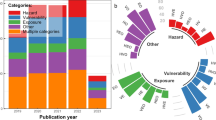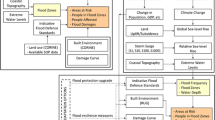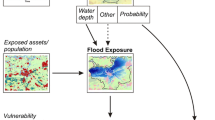Abstract
In the context of growing concern about the threat of flooding posed by climate change in coastal areas, the Spanish plan for coastal adaptation to climate change gave rise to stringent requirements on risk consequence estimates at the regional scale O (100 km). Within this framework, we propose a methodology that combines high space-time resolution climate information (reanalysis databases and projections), local data on exposure that accounts for the most relevant sectors, site-specific vulnerability functions, and flood risk consequence valuation, gridded at 5 m. This approach involves efficient multiple-forcing flood modeling, in which the connection between climate change and potential inundation is primarily established through the definition of a total water level index. This research tackles challenging issues, including the importance of incorporating the effects of existing coastal defenses and local wave effects in port areas, dealing with data at different spatial scales and sectors in an integrated way, and the impact of discounting. The results provide insights into the possible consequences of inaction for a range of future scenarios based on changes in climate and socio-economics over the most relevant sectors. With the goal of prioritizing adaptive action and the efficient assignment of funds, we propose a weight-based integration of the sectoral value-at-risk through the application of Bayesian techniques and expert judgment. The methodology described here was applied to a pilot case study on the coast of Asturias in northern Spain.




Similar content being viewed by others
References
Camus P, Méndez FJ, Medina R et al (2013) High resolution Downscaled Ocean Waves (DOW) reanalysis in coastal areas. Coast Eng 72:56–68
Camus P, Menéndez M, Méndez FJ et al (2014) A weather-type statistical downscaling framework for ocean wave climate. J Geophys Res. https://doi.org/10.1002/2014JC010141
Church JA, Clark PU, Cazenave A et al (2013) Sea Level Change. In: Stocker TF, Qin D, Plattner G-K et al (eds) Climate Change 2013: The Physical Science Basis. Contribution of Working Group I to the Fifth Assessment Report of the Intergovernmental Panel on Climate Change. Cambridge University Press, Cambridge
Cid A, Castanedo S, Abascal AJ et al (2014) A high resolution hindcast of the meteorological sea level component for Southern Europe: the GOS dataset. Clim Dyn. https://doi.org/10.1007/s00382-013-2041-0
Dawson RJ, Dickson ME, Nicholls RJ et al (2009) Integrated analysis of risks of coastal flooding and cliff erosion under scenarios of long term change. Clim Change. https://doi.org/10.1007/s10584-008-9532-8
Egbert GD, Bennett AF, Foreman MGG (1994) TOPEX/POSEIDON tides estimated using a global inverse model. J Geophys Res 99(C12):24821–24852
Federal Emergency Management Agency (FEMA) (2003) Multi-hazard loss estimation methodology, flood model, HAZUS, technical manual. Department of Homeland Security, Emergency Preparedness and Response Directorate, FEMA, Mitigation Division, Washington, D.C.
Gallina V, Torresan S, Critto A et al (2016) A review of multi-risk methodologies for natural hazards: Consequences and challenges for a climate change impact assessment. J Environ Man 168:123–132
GIOC (1999) Grupo de Ingeniería Oceanográfica y de Costas. Documentación del programa MSP-Espectral. Universidad de Cantabria, Santander
Gouldby B, Sayers P, Mulet-Marti J et al (2008) A methodology for regional-scale flood risk assessment. Wat Man 161(3):169–182
Hall JW, Sayers PB, Dawson RJ (2005) National-scale assessment of current and future flood risk in England and Wales. Nat Hazards 36:147–164
Harley MD, Ciavola P (2013) Managing local coastal inundation risk using real-time forecasts and artificial dune placements. Coast Eng 77:77–90
Heberger M, Cooley H, Herrera P, Gleick PH, Moore E (2011) Potential impacts of increased coastal flooding in California due to sea-level rise. Clim Change 109:229–249. https://doi.org/10.1007/s10584-011-0308-1
Jamieson S, Lhomme J, Wright G, Gouldby B (2012) Highly efficient 2D inundation modelling with enhanced diffusion-wave and sub-element topography. Proc. Inst. Wat. Man 165(10):581–595
Lin N, Emanuel KA, Smith JA, Vanmarcke E (2010) Risk assessment of hurricane storm surge for New York City. J of Geophys Res. https://doi.org/10.1029/2009JD013630
Menéndez M, Woodworth PL (2010) Changes in extreme high water levels based on a quasi-global tide-gauge data set. J Geophys Res 115:C10011. https://doi.org/10.1029/2009JC005997
Merz B, Kreibich H, Schwarze R, Thieken A (2010) Review article “Assessment of economic flood damage”. Nat Hazards Earth Syst Sci 10:1697–1724
Mokrech M, Nicholls RJ, Richards JA, Henriques C, Holman IP, Shackley S (2008) Regional impact assessment of flooding under future climate and socio-economic scenarios for East Anglia and North West England. Clim Change 90:31–55. https://doi.org/10.1007/s10584-008-9449-2
Muis S, Güneralp B, Jongman B, Aerts JCJH, Ward PJ (2015) Flood risk and adaptation strategies under climate change and urban expansion a probabilistic analysis using global data. Sci Total Environ 538:445–457
Muis S, Verlaan M, Winsemius HC, Aerts JCJH, Ward PJ (2016) A global reanalysis of storm surges and extreme sea levels. Nat Commun. https://doi.org/10.1038/ncomms11969
Portney, P. R., & Weyant, J. P. (Eds.). (1999). Discounting and intergenerational equity. Resources for the Future
Reguero BG, Menéndez M, Méndez F, Mínguez R, Losada IJ (2012) A global ocean wave (GOW) calibrated reanalysis from 1948 onwards. Coast Eng 65:38–55
Reguero BG, Losada IJ, Díaz-Simal P, Méndez FJ, Beck MW (2015) Effects of Climate Change on Exposure to Coastal Flooding in Latin America and the Caribbean. PLoS One. https://doi.org/10.1371/journal.pone.0133409
Slangen ABA, Carson M, Katsman CA et al (2014) Modelling twenty-first century regional sea-level changes. Clim Change. https://doi.org/10.1007/s10584-014-1080-9
Stern N, Taylor C (2007) Climate change: Risks, Ethics and the Stern Review. Science 317(5835):203–204
Stockdon HF, Holman RA, Howd PA, Sallenger AH Jr (2006) Empirical Parameterization of Setup, Swash, and Runup. Coast Eng 53:573–588
Taylor KE, Stouffer RJ, Meehl GA (2012) An Overview of CMIP5 and the Experiment Design. Bull Amer Meteor Soc 93:485–498
Ward PJ, Jongman B, Salamon P et al (2015) Usefulness and limitations of global flood risk models. Nature Clim Change 5:712–715. https://doi.org/10.1038/nclimate2742
Wind HG, Nierop TM, de Blois CJ, de Kok JL (1999) Analysis of flood damages from the 1993 and 1995 Meuse flood. Water Resour Res 35(11):3459–3465
Wong PP, Losada IJ, Gattuso J-P et al (2014) Coastal systems and low-lying areas. In: Field CB, Barros VR, Dokken DJ et al (eds) Climate Change 2014: Impacts, Adaptation, and Vulnerability. Part A: Global and Sectoral Aspects. Contribution of Working Group II to the Fifth Assessment Report of the Intergovernmental Panel on Climate Change. Cambridge University Press, Cambridge, pp 361–409
Acknowledgements
This work has been supported by the Spanish Ministry of Agriculture and Fishery, Food and Environment (MAPAMA). The authors would like to acknowledge the technical assistance and data provided by the Government of Asturias. The authors are also grateful to the climate modeling groups for producing and making their model outputs from CMIP5 available.
Author information
Authors and Affiliations
Corresponding author
Electronic supplementary material
ESM 1
(PDF 1.17 mb)
Rights and permissions
About this article
Cite this article
Toimil, A., Losada, I.J., Díaz-Simal, P. et al. Multi-sectoral, high-resolution assessment of climate change consequences of coastal flooding. Climatic Change 145, 431–444 (2017). https://doi.org/10.1007/s10584-017-2104-z
Received:
Accepted:
Published:
Issue Date:
DOI: https://doi.org/10.1007/s10584-017-2104-z




